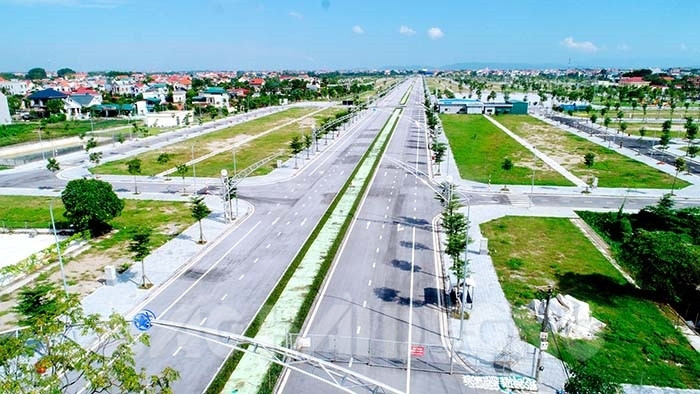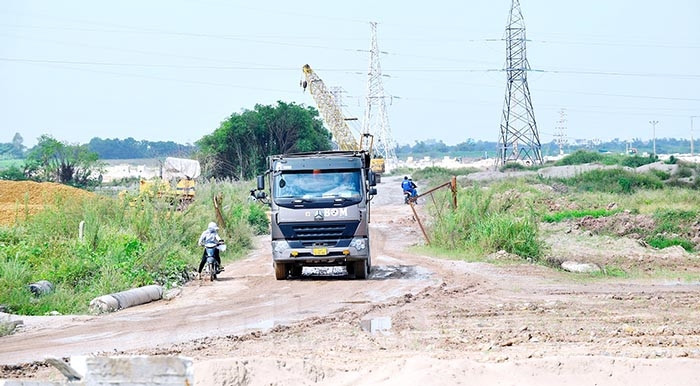When the State changes the land use purpose from rice cultivation, perennial crop cultivation, aquaculture... to residential land, commercial service land, the land value increases. However, the added value - also known as differential rent - mainly falls into the hands of project investors.

Land in the new residential project west of Nam Sach town has a fairly high price after being invested in synchronous technical infrastructure.
Inadequate compensation price for land clearance
Land clearance (GPMB) to recover land for project development is currently facing many difficulties. The area of land recovered for roads and public welfare projects is agreed upon by the majority of people, but land recovery projects for residential and urban areas face many difficulties.
The project to invest in building the northeastern ring road of Thanh Mien town under the BT (build-transfer) form is implemented by a consortium of 3 LLCs: Anh Quang Investment, Thai Duong Construction and Commercial Services Investment, and Hoang Thanh. The total length of the road is 3.88 km, connecting National Highway 38 with Provincial Road 392 through Thanh Mien district, with a cross-section of 33 m, using more than 18 hectares of land. The cost of building the road is covered by the Thanh Mien new urban area project with a planned area of more than 91.3 hectares. Up to this point, the land acquisition for the road area has basically gone smoothly, but the land acquisition for the Thanh Mien new urban area has encountered many difficulties because the people do not agree with the compensation plan.
Many people do not accept the compensation price according to the land price framework prescribed by the State, leading to many prolonged lawsuits, slowing down the progress of putting projects into operation. They believe that the current compensation policy for land acquisition and clearance is unfair and beneficial to investors. The compensation price for people whose rice fields are recovered is theoretically applied according to market prices, but because there are no transactions, when approving the compensation plan for land acquisition and clearance, the Provincial People's Committee approved an adjustment coefficient of 1, equal to the land price framework prescribed by the State, averaging about 120 million VND/sao. When the recovered land is converted to residential land, it is handed over to investors to build technical infrastructure and then resold to people at market prices, up to tens of millions of VND/m2.2.
The project to invest in building a residential area north of the Huong River, Tan Viet Commune (Thanh Ha) with a scale of nearly 9.8 hectares, mainly rice fields, perennial crops, and irrigation land, invested by AH Group Joint Stock Company. Currently, the project is in the stage of completing technical infrastructure construction, submitting documents to the Provincial People's Committee for approval of prices to calculate land use fees. Although the investor has not yet fulfilled its financial obligations to the State, the land of this project has been sold by some real estate floors in the province from 13.5 million VND/m2.2more than a year ago. Up to now, the land price here is being advertised by land brokers for over 20 million VND/m2. With this price, the amount of money people have 360 m2received rice land can not buy 10 m2land
The huge difference between the compensation price for people whose land was recovered for real estate projects and the land price that people had to buy back on their own recovered land led to difficulties in site clearance. DVS Vietnam Investment Joint Stock Company was assigned by the Provincial People's Committee to implement the new residential area project in Doan Tung commune (Thanh Mien) since September 2017. After 3 years of persistent campaigning, 28 households with 1.6 hectares of agricultural land still did not accept the compensation and site clearance plan prescribed by the State, leading to complicated complaints. After many unsuccessful dialogues, in November 2020, the Thanh Mien District People's Committee was forced to enforce the land handover to the investor to implement the project.

The joint venture of investors Licogi18 - Licogi18.1 won the project of the road connecting Han bridge with National Highway 37 and was reciprocated with the project of the new urban area north of Han bridge.
"3 houses" benefit together
The reason why the compensation price for people whose land is recovered is low and cannot keep up with the continuous fluctuations of the real estate market is the land price framework stipulated in the 2013 Land Law (amended). The Government issues a land price framework every 5 years. During the implementation of the land price framework, if the common land price on the market increases by 20% or more compared to the maximum price or decreases by 20% or more compared to the minimum price in the land price framework, the Government will adjust the land price framework accordingly. Based on the land price framework, the Provincial People's Committee will develop and submit to the Provincial People's Council for approval a land price list before promulgation. The land price list is developed every 5 years and announced on January 1 of the first year of the period. During the implementation of the land price framework, when the Government adjusts the land price framework or the common land price on the market fluctuates, the Provincial People's Committee will adjust the land price list accordingly through the form of adjustment coefficients.
With the current land policy, investors are the ones who benefit the most when the State reclaims land and hands it over to investors to develop residential land projects. With the regulation on calculating land prices at the time of land allocation, the differential rent mainly falls into the pockets of project investors. A residential land development project when reclaimed and handed over to investors for implementation and land use fees are calculated at the time of land allocation when there is no technical infrastructure, the value of that land is low. When the technical infrastructure is completed, the value of that land increases many times. Meanwhile, the cost of technical infrastructure is deducted from the land use fees.
It can be seen that an administrative decision to change the land use purpose to residential land increases the land value, the investor is the beneficiary. For investors implementing land-for-infrastructure projects, investing through the BT form, the profits are even higher when the road that the State spends money to build through land exchange has itself increased the value of the land that the investor is assigned... For many state-owned enterprises after equitization, the land of the enterprise is not implemented according to the original equitization plan but is changed to residential land, divided into lots, and sold, causing the value of the land to increase.
The draft Land Law 2023 (amended) has removed the price framework, only retaining the land price list. The land price list is also built annually, instead of every 5 years as at present. This is considered a breakthrough policy to remove the "bottleneck" in developing compensation plans for people whose land is recovered to approach market prices. The Land Law 2023 (amended) needs to stipulate the time for calculating land prices to determine land use fees for real estate projects, thereby calculating land prices according to market value after the investor completes technical infrastructure. From there, determine the differential rent, ensuring harmony of interests among the "3 houses": the State, people whose land is recovered, and project investors. In addition, it is necessary to closely monitor the land of state-owned enterprises after equitization. In case the enterprise after equitization does not properly implement the approved equitization plan, especially land, the State needs to reclaim the project to assign the investor to better implement with the same land use purpose. In case of changing the purpose to residential land, it is necessary to auction the land use rights or bid for the project using land to select the investor according to regulations, to avoid causing loss of State assets.
SY THANG
Next: Many shortcomings in land pricing